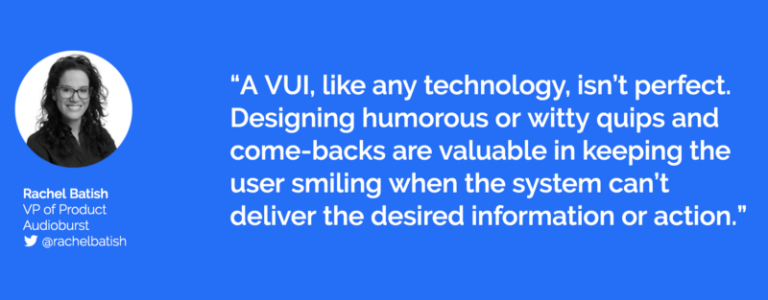By Rachel Batish, VP of Product, Audioburst (@rachelbatish)
Voice assistants are already replacing human interactions across industries and use cases. Is your team exploring a voice strategy or do you already have one? In order to create a positive and friendly experience, it’s not enough to just have a voice-enabled product or service. Companies should prioritize creating a unique personality for their assistant that aligns with their brand mission and values.
Best practices for creating meaningful voice experiences include using intuitive and human dialogue, small talk, humor, empathy, and adding emotional intelligence to your voice assistant. Additionally, there’s the question of visual representation. Does your assistant need an avatar? How will you approach the gendered identity of your assistant? And how can you create a persona that resonates with your specific target audience?
Keep in mind that with voice assistants, personality is more than just an icon or an avatar. It’s also the voice, the language it uses, and the ability to create a safe and supportive environment for your users.
How would you define who your voice assistant is if he/she was a person? What kind of personality do you want to attach to the person? What kind of personality are your users expecting it to have? I’ve gathered a few best practices on how to deal with some of the challenges in defining the personality of your voice assistant below:
Summon your Voice Assistant (VA) for an interview
Well, not a real job interview, but regardless of whether the VA is replacing or extending a previous human-interaction, or meeting a whole new need, we can learn a lot about its personality by creating a job description for its role.
To write the requirements and qualifications of this VA, you should first investigate the clients with whom your VA will interact. In fact, defining your customers’ identities is the first step of building your VA’s personality.
Answering simple questions like, “Are your clients professional or leisure users?” Defining their age range, gender, geographic spread, and language preference can help you build your VA’s job description more accurately. Now that you have answers to those questions, you can start building the characteristics you are looking for in your “new hire.” These qualities could be, “How many years of experience should it have?” or “What is the level of education required for the role?” But more importantly, are its “soft skill” characteristics, its language, and type on point?
Building this job description also helps you to narrow down the VA’s tasks and capabilities, which will, in turn, impact its personality. For example, if the VA is supposed to provide you with account information, it should be formal and knowledgeable, but if it offers kids’ entertainment, it should be friendly, funny, and maybe more didactic.
Once you have figured out who your VA is based on its target audience and role, building its personality will be much easier. But first, we need to define its gender.
He, she, both, or nothing at all?
Gender transparency is a key component of your VA’s personality. Whether you choose to give your VA a gender or not, be sure that based on their expectations and interactions with it, your users can do that. Gender transparency can help you create trust among your users as well as increase usage and efficiency.
Another near-field environment example would be a mobile phone because people tend to bring the phone right up to their mouth and speak directly into the microphone. Oftentimes, they even speak too loud. So we have to address that environment where there’s a distortion based on how close they are and how loud they are speaking to the device to wake it up.
What we’ve seen over the last few years is that we’re starting to make lots of improvements, not just incremental improvements in the quality and ability to recognize wake words, but really exponential improvements in various environments.
Voice-enabled virtual assistants are more likely to be gendered due to the voice component. Unlike visual assistants (bots), their voice signals to the user if they are male or female. Though in some cases, such as in navigation apps, the decision of which gender’s voice is used is left to the user.
Based on our target audience and job description, we can start planning the gender of our VA. Some cases are easier to decide on: If I’m building a VA to support young women during their first months of pregnancy, I’d probably choose female characteristics and voice for my VA.
But what if my audience is mixed and I’m not sure about its preferences?
Like everything in life, we should put this to the test and see what people react best to. We can start by simulating an interaction and seeing what our users’ expectations are for our VA, focusing on the gender perspective.
(One of the problems here is that as a society, we continue to nurture gender bias for specific roles. By providing the opposite, we might be able to challenge this tendency… but that is a post for another day.)
Gender transparency also creates trust among users. Continuing the previous example, a young mom looking for breastfeeding advice may appreciate it coming from a “female” figure, rather than a “male” one. In this case, it is very easy to put it to the test; after all, if this young mom had gone to a breastfeeding counselor in person, the chances are that she would have ended up talking to a woman.
Find a way to give it a unique ‘Voice’
With the utilization of today’s popular voice-enabled devices comes the limitation of not being able to give your VA a unique voice. While Google and Siri do offer a couple of voices to choose from, (Alexa is currently limited to only one), this situation is far from supporting your unique branding and personality.
Many companies are trying to solve this problem, and I found the creativity of the insurance company GEICO very interesting:
GEICO’s Gecko has become a familiar character over the years, thanks to its media appearances on radio and TV. In its efforts to extend the Gecko’s special personality into voice-enabled devices, GEICO used pre-recorded MP3 files with the Gecko’s voice in their skill, letting the user know that “they are in the right place.” So while most of the dynamic interaction was done using the Alexa-integrated voice, greetings and closing remarks were handled by the unique personality of the Gecko, with its own humorous and sophisticated attitude.
The “attitude” is another aspect of your VA “voice.” It is the style, tone, little nuances, and the atmosphere it creates. Should it have a formal style? Should it sound relaxed and calming? Should it energize your users and keep them awake? When these questions are asked and answered, it is much easier to define your VA’s voice.
Small talk = Big success
If there’s anything that will connect your users with your VA, it is small talk. Either as side-interactions or as part of the main discourse, it’s the small talk that people will remember.
Small talk and chatter are good for creating trust and stickiness, but they are also valuable in keeping the user smiling when the system can’t deliver the desired information or action. The more chatter sentences and events you put into your bot, the better it is. While it is not a huge investment for you, it makes a huge difference for the user.
Last but not least — Your VA is alive, continue to nurture it
Now that it has a personality, a voice, and a unique style, we understand that we have created not just a personality, but some type of person! Like us, our VA grows every day, learns new things, and adapts to its surroundings. Make sure to track its behavioral success. Modify, add, introduce, and omit what’s needed in its personality to make your users feel that they are in the safe and supportive environment of your business.
If you’d like to learn more about designing a successful Voice assistant for your brand, read our in-depth best practice guide on building a better voice user interface (VUI) featuring 15+ experts and thought leaders.
Rachel Batish is an accomplished entrepreneur and author specializing in voice and voice search. As the VP of Product at Audioburst, she is responsible for driving product strategy with some of the biggest brands including Samsung, LG and Bytedance. Follow her on Twitter @rachelbatish











